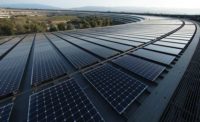For construction and engineering professionals, it’s a happy day. The realities of American politics have not seen much partisan agreement, but Congress managed to agree on something recently: If your work relates to energy-saving design and engineering, then your business may be entitled to a very lucrative tax deduction.
The U.S. government has recognized the irrefutable driving influence that the AEC industry has on the future development of our local communities, our energy infrastructure and even our global standing.
The Energy–Efficient Commercial Building Deduction, better known as IRS section 179D, rewards green construction with powerful tax savings that provide a significant means for reinvestment—money that will find itself recirculated back into local economies.
The 179D tax deduction is an attractive proposition for an engineer, architect, builder, environmental consultant or energy-services provider. To qualify, you must have worked on a building located in the U.S. that has either undergone new construction or energy-efficient retrofits and was placed into service during an open tax year.
Given the choice, most builders would probably prefer to have a project portfolio filled with government and municipal buildings (think schools, courthouses, etc.) for the sake of claiming 179D.
Here’s why: Since government entities do not pay tax, they are precluded from claiming a tax deduction. But that doesn’t mean that the benefit has to go to waste. The tax law allows the government entity that owns the building to earmark the deduction to a contractor who performs the energy-efficient work.
How Much of a Deduction?
Eligible contractors can expect to receive a tax deduction directly proportional to the percentage of their energy-reducing contributions, one square foot at a time.
After a building is placed into service, its energy yield can be either calculated partially, divvied up by three categories of systems (lighting, HVAC or building envelope) or it can be calculated by the building’s overall power reduction. The deduction can be up to $1.80 per sq ft.
Those dollars and cents add up quickly in large municipal buildings, like airports, so it’s critical that you quantify even fractional contributions.
One of the most generous features of 179D is the option to amend previous returns going as far back as 2011 or 2012, so even if you’re just learning about 179D, you can still claim older projects.
Many companies are shocked when their accumulated savings from look-back years climb into seven- or eight-digit dollars, so be mindful of the upcoming March 15 and April 15 filing deadlines.
Asking for Allocation
If you want something, you have to ask for it. That’s life, and that’s 179D.
As previously mentioned, a government entity can bestow its building’s tax deduction to a contractor. The deduction is transferred by way of a document called an allocation letter, which identifies a contractor as the rightful recipient of the building’s tax benefit.
One of the biggest challenges of 179D is navigating the allocation process. It’s highly recommended that candidates pursue their allocation letters with urgency because 179D is usually a first-come, first-serve proposition. Since there are often multiple builders and engineers attached to a project, it’s crucial to request your allocation letter without delay before another contractor beats you to the punch.
One of the final steps in claiming 179D requires that you verify the energy reduction. An independent, third-party inspection must be completed by a qualified engineer licensed in the state. The inspector will use energy simulation and modeling to verify the energy savings before the IRS will justify your deduction. The baseline standard was raised to ASHRAE 90.1 – 2007 in 2016. All previous years are held to ASHRAE 90.1 - 2001 standards.
While these steps may appear simple, the reality of 179D’s administration is far more complicated in practice. A short phone call with a qualified consultant can cut through several steps and determine whether a project is 179D eligible and whether it makes sense from a tax perspective for the company.
179D Helps AEC Firms Thrive
It’s hard to believe that this little-known tax deduction with big-time profit potential has been available for more than 10 years. But the 179D deduction is proof that if energy contractors and our public institutions work together, they can continue to accomplish great things. Growing your business, fueling economic growth and relieving pressure on the nation’s infrastructure along the way is a triple victory for the AEC industry.
|
Government contracts are incredibly lucrative for a couple of reasons. First, the work tends to be steady and enduring. And second, government facilities, like military bases, are enormous and every square foot counts when you’re claiming 179D. A West Coast-based firm that specializes in mechanical and electrical engineering had a succession of jobsites at five military bases in the course of just one year. Working to retrofit cargo and airfreight spaces, the firm performed various installations, including: economizers, variable frequency drives, variable air volume system, direct digital controls, T8 fluorescent lights and occupancy sensors. In total, the firm completed 620,000 sq ft of energy-efficient renovations, receiving 179D benefit allocations from all five properties totaling $354,962. |




Post a comment to this article
Report Abusive Comment